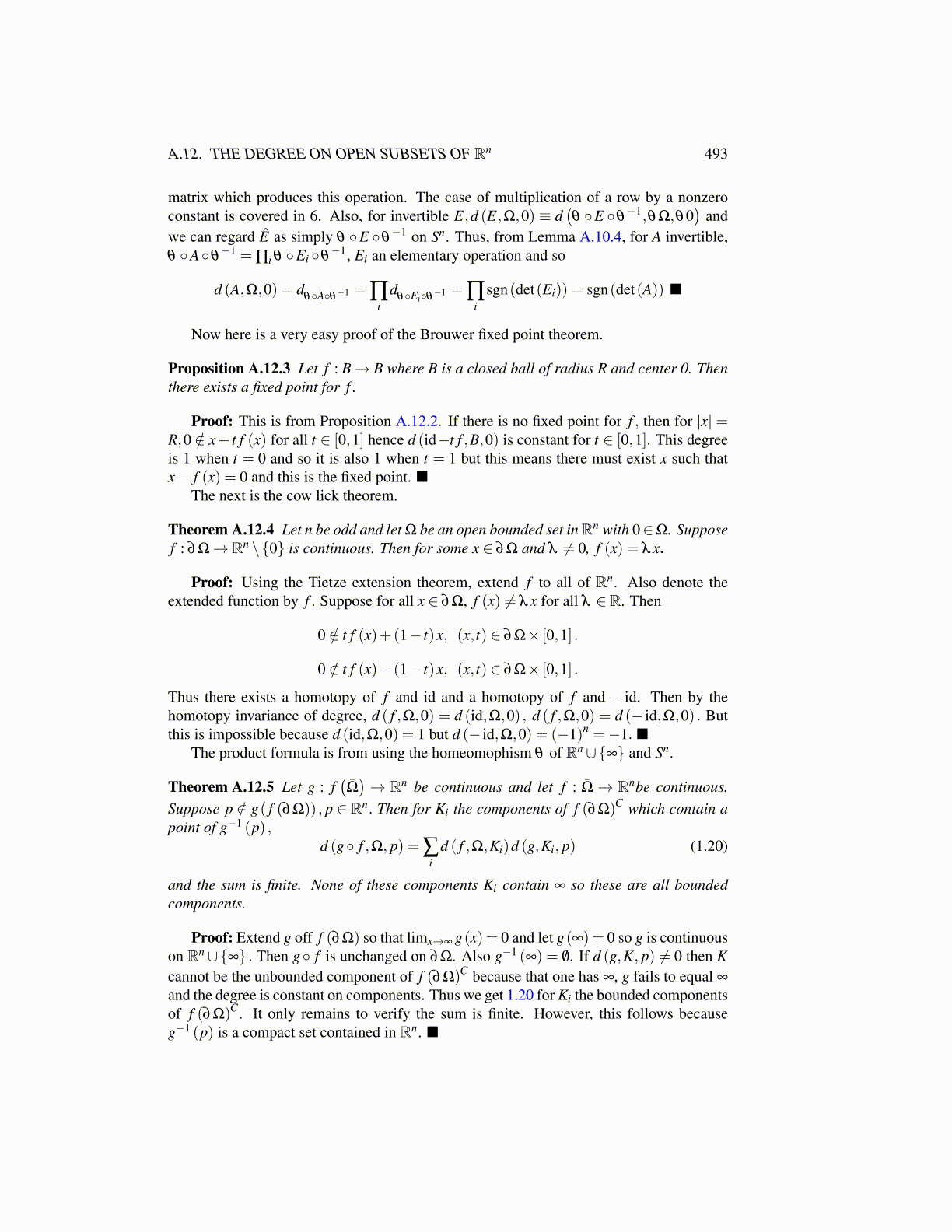
A.12. THE DEGREE ON OPEN SUBSETS OF Rn 493
matrix which produces this operation. The case of multiplication of a row by a nonzeroconstant is covered in 6. Also, for invertible E,d (E,Ω,0) ≡ d
(θ ◦E ◦θ
−1,θΩ,θ0)
andwe can regard Ê as simply θ ◦E ◦θ
−1 on Sn. Thus, from Lemma A.10.4, for A invertible,θ ◦A◦θ
−1 = ∏i θ ◦Ei ◦θ−1, Ei an elementary operation and so
d (A,Ω,0) = dθ◦A◦θ−1 = ∏
id
θ◦Ei◦θ−1 = ∏i
sgn(det(Ei)) = sgn(det(A)) ■
Now here is a very easy proof of the Brouwer fixed point theorem.
Proposition A.12.3 Let f : B→ B where B is a closed ball of radius R and center 0. Thenthere exists a fixed point for f .
Proof: This is from Proposition A.12.2. If there is no fixed point for f , then for |x| =R,0 /∈ x− t f (x) for all t ∈ [0,1] hence d (id−t f ,B,0) is constant for t ∈ [0,1]. This degreeis 1 when t = 0 and so it is also 1 when t = 1 but this means there must exist x such thatx− f (x) = 0 and this is the fixed point. ■
The next is the cow lick theorem.
Theorem A.12.4 Let n be odd and let Ω be an open bounded set inRn with 0∈Ω. Supposef : ∂Ω→ Rn \{0} is continuous. Then for some x ∈ ∂Ω and λ ̸= 0, f (x) = λx.
Proof: Using the Tietze extension theorem, extend f to all of Rn. Also denote theextended function by f . Suppose for all x ∈ ∂Ω, f (x) ̸= λx for all λ ∈ R. Then
0 /∈ t f (x)+(1− t)x, (x, t) ∈ ∂Ω× [0,1] .
0 /∈ t f (x)− (1− t)x, (x, t) ∈ ∂Ω× [0,1] .
Thus there exists a homotopy of f and id and a homotopy of f and − id. Then by thehomotopy invariance of degree, d ( f ,Ω,0) = d (id,Ω,0) , d ( f ,Ω,0) = d (− id,Ω,0) . Butthis is impossible because d (id,Ω,0) = 1 but d (− id,Ω,0) = (−1)n =−1. ■
The product formula is from using the homeomophism θ of Rn∪{∞} and Sn.
Theorem A.12.5 Let g : f(Ω̄)→ Rn be continuous and let f : Ω̄→ Rnbe continuous.
Suppose p /∈ g( f (∂Ω)) , p ∈ Rn. Then for Ki the components of f (∂Ω)C which contain apoint of g−1 (p) ,
d (g◦ f ,Ω, p) = ∑i
d ( f ,Ω,Ki)d (g,Ki, p) (1.20)
and the sum is finite. None of these components Ki contain ∞ so these are all boundedcomponents.
Proof: Extend g off f (∂Ω) so that limx→∞ g(x) = 0 and let g(∞) = 0 so g is continuouson Rn∪{∞} . Then g◦ f is unchanged on ∂Ω. Also g−1 (∞) = /0. If d (g,K, p) ̸= 0 then Kcannot be the unbounded component of f (∂Ω)C because that one has ∞, g fails to equal ∞
and the degree is constant on components. Thus we get 1.20 for Ki the bounded componentsof f (∂Ω)C. It only remains to verify the sum is finite. However, this follows becauseg−1 (p) is a compact set contained in Rn. ■